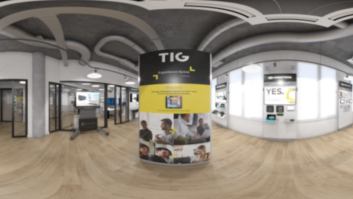 The modern classroom is undergoing a radical transformation, reshaped by technology and driven by the evolving needs of a digital-centric generation. As we look to the future, it’s clear that AV requirements across educational institutions are also evolving rapidly, particularly the trend towards universal integration with USB devices and user-friendly control.
The modern classroom is undergoing a radical transformation, reshaped by technology and driven by the evolving needs of a digital-centric generation. As we look to the future, it’s clear that AV requirements across educational institutions are also evolving rapidly, particularly the trend towards universal integration with USB devices and user-friendly control.
With the shift in classroom technology to the universal adoption of USB devices, many universities are increasingly utilising Pan-Tilt-Zoom (PTZ) and fixed cameras for enhanced interactive experiences, where USB connectivity plays an integral role. Coupled with USB microphones, whether speakerphones or those connected to digital signal processors, these devices have become standard requirements in modern classroom settings.
In addition, the transition from HDMI to USB for document cameras highlights the importance of ensuring easy sharing and compatibility with a variety of computer systems. To optimise this USB-centric environment, however, universities need solutions that allow easy switching between video and device inputs.
Enter the video switcher, which ensures seamless transitions and connections for instructors. This technology ensures that interactive displays and touchscreens can seamlessly integrate with the existing setup, further enhancing the interactive learning experience.
Across the board, the rate of tech-led progress is accelerating, bringing with it both opportunities and risks. While VGA and DVI connectors are being phased out, USB-C and HDMI are emerging as the new standards for laptop connectivity in classrooms. As educational institutions continue to update and innovate, rooms with outdated VGA connections will become rare, giving way to more modern, efficient connectors.
In addition, the proliferation of 1 Gbps AV over IP solutions means universities can easily stream lectures to centralised recording systems. This approach makes lectures accessible, allowing students to revisit classes via the Learning Management System (LMS) of their choice.
However, an increase in classroom cameras also comes with its challenges. These include GDPR concerns over student privacy, especially the provision of live session recordings, where the original real-time interactions are key. The solution lies in the ability to blur out faces in post-recording phases, ensuring privacy while maintaining interactivity.
ACCELERATED RATE
In a surprising twist, many classrooms still consider chalkboards as indispensable tools. Here, the challenge is to make chalkboard content accessible to remote students. In response to these needs, innovative solutions, such as PTZ cameras or dedicated camera operators, can capture this content for students attending virtually.
Looking further into the future, the direction of travel is to create classrooms that are even more intuitive so that teachers and students simply need to plug in a device, and the system responds appropriately. This shift towards automation, facilitated by the widespread BYOD culture, sets the tone for the future of educational AV.
As AV technologies continue to evolve, educational institutions must keep pace. By recognising and addressing these important tech-led developments, from the ubiquitous use of USB devices to the transition to newer connectors or the seamless integration of old and new teaching methods, the future of AV in education is exciting for teachers and students alike.







